SASS® 3100 Dry Air Sampler
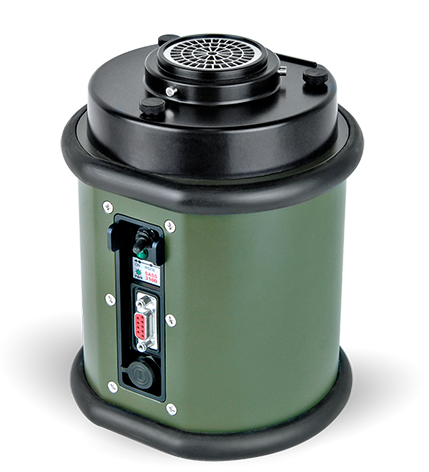
The SASS® 3100 dry air sampler system is a compact, rugged, microprocessor-controlled portable air sampler designed for use with state-of-the-art electret filter media. It is ideally suited to the collection of biological and radioactive aerosols. In independent tests performed by third parties, it has out-performed all competitors in terms of collection efficiency and suitability.
SASS 3100 COVID-19 Detection Breakthrough
In November 2021, the SASS 3100 made international news when a team of doctors and scientists in Singapore used it to develop a new, more effective method of detecting airborne SARS-CoV-2. Read more
DOWNLOAD DATA SHEET • REQUEST QUOTE
Product Features
- ISO 14698-1 compliant
- Collection periods may be days in length
- Useable from -40°C to 70°C: no fluids
- High efficiency for sub-micron size pathogens
- Adjustable air flow (biological sampling): 50-300 LPM
- Adjustable air flow (radiological sampling): 10-49 LPM
- User-specified automated protocols
- Wireless control option
- Long-life primary and rechargeable battery options
- Easy decontamination, including fan rotor
- Compact and lightweight
Typical Applications
- Pharmaceutical
- Medical facilities
- Public health
- Clean rooms
- Military
- Food processing
- UAV's (Unmanned Aerial Vehicles)
- Agriculture
- Indoor air quality
- Environmental
- Homeland security
Resources
- SASS 3100 Data Sheet (PDF)
- Safety Data Sheets
SASS 3010 Particle Extraction Kit (PN 7000-162-134-02) (U.S.)
SASS 3010 Particle Extraction Kit (PN 7000-162-134-02) (E.U.)
SASS 3010 Particle Extraction Fluid (PN 7000-162-133) (U.S.)
SASS 3010 Particle Extraction Fluid (PN 7000-162-133) (E.U.)
SASS 3010 Wash Fluid (PN 7000-162-132) (U.S./E.U.) - SASS 3100 Product Bibliography
- Using the Sterile Particle Extractor (PDF)
- TECH NOTE: Comparison of SASS 3100 Filter Types (PDF)
- TECH NOTE: Syringe Method for Processing SASS 3100 Filters (PDF)
- TECH NOTE: Candidate Disinfectants for Research International Products (PDF)
- TECH NOTE: Evaporation Rates for Microorganisms Captured by Research International’s Electret Filters (PDF)
- TECH NOTE: Power Measurements and Battery Life Estimates (PDF)
- Influenza Virus Collection and Detection from Electret Filters - White Paper (PDF)
- Test Chamber setup for characterizing filter collection efficiency over 0.3 to 10.0 micron aerosol range (PDF)
- Comparison Chart: SASS Air Samplers
- A Comparison of Portable Air Samplers (PDF)
- SASS 3010 Particle Extractor Data Sheet (PDF)
- Bluetooth Biolink™ Wireless Units provide plug-and-play wireless communication between any Research International product and a remote PC or laptop.
Operational Details
In a recent test that compared the performance of ten different wet and dry portable sampling systems from different manufacturers at the U.S. Army’s Edgewood CB Center, the SASS 3100 was the top performer, as shown in Figure 1.
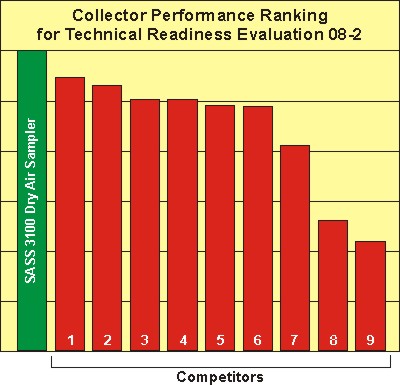
Figure 1: Sampler performance results of ten different wet and dry portable sampling systems from different manufacturers at the U.S. Army’s Edgewood Chemical Biological Center.
The capture element is a 44 mm diameter felt-like polymer disc. Each fiber in the disc has an electric field frozen into it. These fields induce a charge in aerosols passing through the filter and provide a capture mechanism much more effective than impaction; up to 50X more efficient than conventional glass or cellulosic filters. This ‘electret’ media is stable to 70°C, is virtually inert, has a shelf life of 10 years, and has high holding capacity due to a large internal surface-to-volume ratio.
A microprocessor controls blower speed and provides diagnostics through fully dimmable LED indicators that warn when battery power is low and when the fan is not rotating. The unit may be controlled remotely via an RS-232 communications link, or with an optional RF link.
Ref.1: Test Report, Technology Evaluation Readiness Evaluation 08-2, CBR Technology Evaluation Branch, Edgewood CB Center, U.S. Army RDECOM, December, 2008.
Disposable Filter Element
A key component is the disposable snap-on filter element (Figure 2). At the center of the element’s 60 mm diameter injection-molded frame is an acoustically-welded 44 mm diameter micro-fibrous capture disc. Figure 3 shows collection efficiency as a function of particle diameter for polystyrene test beads. Particles with diameters in the range of 0.3 to 0.5 µm are captured with almost 50% efficiency by the disc, while particles of 1.0 µm diameter or larger are captured at 80% or better efficiency.
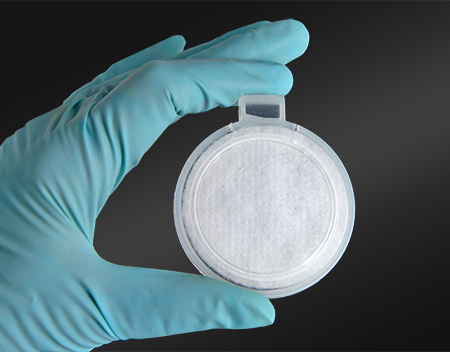
Figure 2: Snap on electret filter.
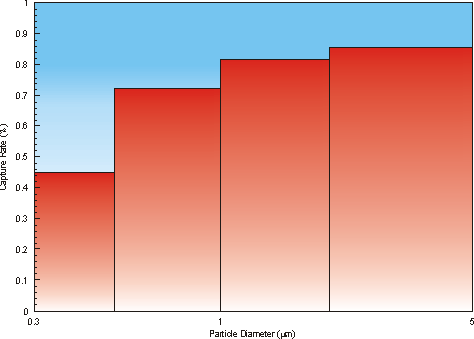
Figure 3: Absolute capture rates for airborne particles in the 0.3 to 5.0 µm diameter range at the nominal air sampling rate of 360 L/min. Base particles are 0.90 µm diameter polystyrene microspheres. Other particulate sizes have been generated through agglomeration or fractionation. Ambient conditions: Atmospheric pressure and 22°C.
Collection efficiency changes by a relatively small amount over a suggested 50 to 300 liters/min. sampling range (See Figure 4). At an airflow of 120 LPM, the collection efficiency is about 92% for particles in the 0.5 to 5.0 micron size range. At the maximum airflow of 310 LPM, the collection efficiency falls to about 78-79% for similar-size particles, but the overall capture rate is nonetheless much greater at the higher flow rate.
Aerosol particle velocities are relatively low at the filter face as compared to particle velocities in sieve impactor collectors. At the maximum airflow of 320 liters/min., the effective air flow velocity at the filter face is about 3.5 m/sec. Impaction velocities on the order of 20 m/sec are common in sieve collectors used for biocontamination measurements under international standard ISO 14698-1. The relatively open structure of the filter (it has a void volume in excess of 96%) and the low face velocities offer relatively benign capture conditions for delicate microorganisms. As compared to conventional dry media such as glass filter papers and Nuclepore-style membrane filters, Research International’s electret media is much less harsh on captured organisms.
The surface-to-volume ratio of a microorganism is very large and surface mass transfer processes will rapidly equilibrate a microorganisms water content with the surrounding air. This equilibration process will not be materially hastened by air flow velocities used in the SASS 3100. That is, Research International’s electret filters should not measureably speed up the dehydration of humidity-sensitive aerosols.
The filter element can provide a liquid sample suitable for a wet bioassay after being processed in the SASS 3010 Manual Extractor, or the capture disc portion may be placed directly in a 50 mm petri dish for a culture-based assay.
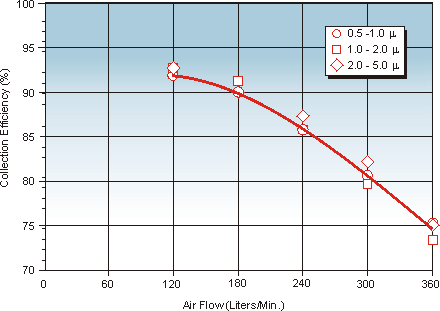
Figure 4: The effect of varying the airflow on SASS 3100 collection efficiency for particles in the 0.5 to 5.0 micron diameter range. Polystyrene microspheres, 1.05 g/cc density.
Figure 5 shows capture efficiency for 0.9 µm polystyrene microspheres over an extended 7.5 hr collection period, during which time over 140 million particles/cm2 were deposited. The figure shows that collection efficiency for particulates in the 0.5 to 5.0 µm range actually increased a modest amount, approximately 20%, over that period. The filter pressure drop also increased a modest 20%.
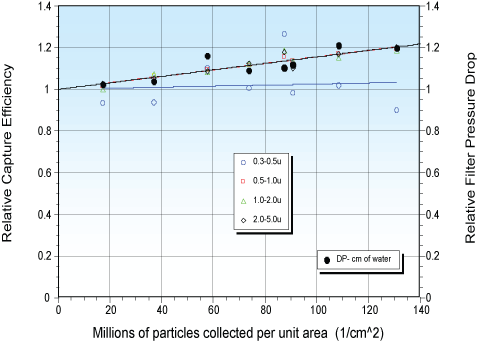
Figure 5: The change in filter collection efficiency for particulates in the 0.3 to 5.0 µm size range as a function of the number of particles collected. After being subjected to 140 million particles/cm2, the collection efficiency (as well as the filter pressure drop) increases a modest 20%. Air flow through the filter drops by a corresponding amount. For this 7.5 hour-long test, the average particulates concentration was about 460,000/ft3. The particulates were 0.9 µm polystyrene spheres and fractions/aggregates thereof.
Fan Unit
The centrifugal fan is driven by a brushless DC motor with an expected lifetime of 30,000 to 40,000 hours. Fan power consumption is nominally 8 W and noise levels are 45–61 dB (A) at 1 m. Figure 6 shows the effect of rotational position on the maximum sound level. The ‘zero angle’ position corresponds to the centerline of the air discharge port. It can be seen that the peak sound level occurs at a rotational position of 30 degrees relative to the air discharge port position.
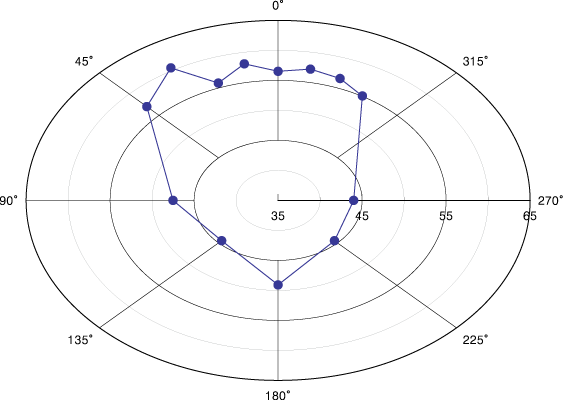
Figure 6: Noise footprint of SASS 3100 dry air sampler: Peak acoustic level (dB-A) at 1 meter versus circumferential position. Zero degrees corresponds to the exhaust duct's rotary position, while the carrying handle is positioned at 180 degrees.
Electronics
Electronic subsystems are under the control of an embedded microprocessor, and many operating characteristics such as fan speed and sampling behavior, can be permanently or temporarily changed using Windows© software provided with the system. The unit may be operated manually, by the Windows software, or by other serial port-connected equipment.
An RS-232 serial port is provided. Options include an RS-232 to USB adaptor and a modular RF link that mounts to the RS-232 connector. The standard connector is a commercial DB-9, but a military CCSI style is available.
Long Battery Operating Times
The SASS 3100 can be used with two different lithium ion-based batteries - the BA-5590/U primary and the UBI 2590 rechargeable battery. Their capacities are respectively 210 and 250 watt-hours at 20C. These capacities translate into continuous run times of approximately 21 and 25 hours, respectively. If the SASS 3100 is on standby, that is, the fan is not running, these batteries can power the units for about 8.75 and 10.4 days, respectively.
For customers who will use the sampler frequently, we suggest purchasing the rechargeable battery and its electronic recharger. These two items are about the same price as six primary batteries, so the rechargeable approach may pay for itself in a short time if the SASS 3100 will see heavy usage and the continuous and standby run times with the rechargeable battery are acceptable.
Battery life is monitored in two ways: by ampere-hours of electrical power consumed, and by battery voltage. In the field, a low battery condition is signaled by blinking of the green “Power” LED. When the sampler is connected to RI’s SASS 3100 software by the serial data link, two indicators of battery life are displayed at the PC - a “Percent Capacity” number based on ampere-hours, and raw battery voltage.
For situations where mains power is available, a universal (IEC 320) wall-plug power supply accepts 82-265 VAC at 47-63 Hz.
Packaging
The electronics and battery are enclosed in a leak-tight extruded aluminum shell. The fan rotor projects from this main enclosure and is coaxially aligned with and protected by a filter mounting plate affixed to the enclosure face. A carrying handle is provided for transport, along with two ¼-20 camera-style female mounting bosses on the carrying handle and the enclosure bottom surface. Overall dimensions are 15 cm W x 17 cm L x 20 cm H, and weight is 1.8 kg.
Decontamination
The system’s pull-through fan minimizes test-to-test contamination. If the unit needs to be decontaminated, it is designed to be washed or sprayed with a 5% bleach solution or subjected to a gas-phase microbicide. The fan rotor housing, which also serves as the filter mount, can be separated for cleaning from the sampler body by simply unscrewing three finger-tight hold-downs. The fan rotor may be sprayed or dunked without removal from the unit: The SASS 3100 is the only air sampler with an exposable rotor that can be decontaminated in situ. Only the motor shaft and fan rotor are exposed when the rotor housing is removed- the motor and electronics are separately sealed. In the event that the motor shaft seal is corroded by repeated decontamination protocols, it is a comparatively simple process to mount a new motor and rotor.
Accessories/Options
The standard RS-232 connector is of a commercial DB-9 design. However, an optional military CCSI-style connector is also available. Other RS-232 accessories include an RS-232 to USB adaptor, and an RF link that allows communication with a remote PC.
The inlet and outlet ports have also been designed to accept air-tight tube adaptors for applications where either the inlet or outlet airflow must be routed through a hose. For example, the adaptors are useful in applications where the sampler is mounted inside a moving vehicle. Let us quote on your specific needs.
Customizeable Firmware
Users can create a variety of sampling protocols using the PC-based software supplied with the system. User-specific protocols can be stored in a PC and the sampler operated from the PC via a serial data link, or the protocols can be downloaded to the 3100’s memory, causing the 3100 to perform the specified sequence of operations each time it is turned on.
Parameters are set with radio buttons and text boxes in theAutomatic Modewindow, as shown in Figure 7. The air sampling rate is set by moving a slider bar in theFan Speedsection of the window, or by introducing a speed number in theCountstext box. Air flow rates from about 50 to 360 liters/minute can be set.
In theDelay Before First Cycleoptions box, you can set anInitial delay time. This will cause the air sampler to pause before the fan is first actuated. This is useful if sampling needs to emphasize a particular time of day, or if undesireable levels of airborne dust have been generated during set-up. Other text boxes allow you to set how long the fan is on; the amount of pause time there is between samples; and the number of sampling cycles. Alternatively, setting a desired number of total cubic meters of sampled air in theTotal Air Sampledtext box will also define the fan time per collection cycle.
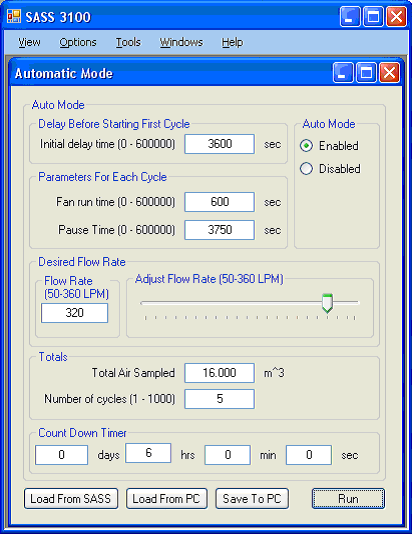
Figure 7: PC-based window for customizing the collection protocol.
Once all parameters have been set, the user has several options:
- TheSave To SASSbutton will transfer these settings to the SASS’s memory. Connection to a PC can be made by an RS-232 cable. A USB adapter is available for PCs that do not have RS-232 capability. Alternatively, Research International’s wireless BioLinks are particularly convenient for remotely controlling one or several 2300s, and eliminate the need for any wires between the PC and the 2300s. Antennas are available with ranges from 100 to 1000 meters.
- TheSave to PCbutton transfers these settings to a file on the PC. These and other stored protocols can be reloaded at a later time using theLoad from PCbutton. This allows several different collection protocols to be saved and then used as needed.
- TheRunbutton allows you to run the protocol directly from the PC. In this mode, the remaining time to complete the sample protocol is shown in theCount Down Timertext window.
Based on the settings illustrated in Figure A, the SASS 3100 has been set to operate at 320 LPM and to collect a total of 16 cubic meters of air over five cycles, spaced 3750 seconcds apart. A one hour initial delay has also been set. The protocol is initiated by either hitting theRunbutton shown in the Figure, or by turning the SASS 3100 on if the protocol has been downloaded to the SASS.
Expert Users
For users who need even more control over the SASS 3100, or need to integrate it into a proprietary monitoring system, the Operating Manual provides the user with a set ofover 20 ASCII commandsthat can be sent over the serial data link to either control or interrogate the sampler.
Parts and Accessories
SASS 3100 Dry Air Sampler Parts and Accessories
To request a price quote, check the box beside the desired item(s), fill out the form at the bottom of the page, and press Submit. We try to respond within two business days.



